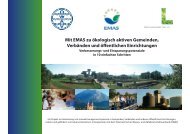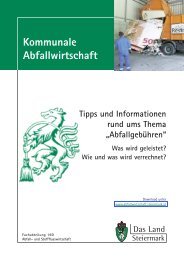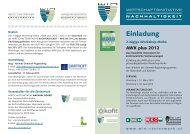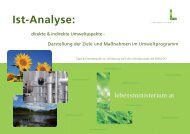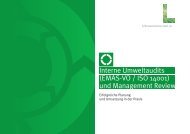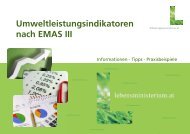proud to save! - bei der Dimitroff Unternehmensberatung
proud to save! - bei der Dimitroff Unternehmensberatung
proud to save! - bei der Dimitroff Unternehmensberatung
Create successful ePaper yourself
Turn your PDF publications into a flip-book with our unique Google optimized e-Paper software.
Dušan Novkovič<br />
in Slovenia: Best Practice Examples<br />
Use of electric arc furnace waste heat for<br />
heating, preparation of sanitary hot water and<br />
steam production<br />
“My expectations for the course were very high and they<br />
were fulfilled 110 % – I was very satisfied with<br />
the contents and organisation of the training and I wish<br />
JSI team a lot of success also in the future.”<br />
Energy concept description: Cooling of an electric arc furnace is<br />
carried out using heat exchangers and two cooling <strong>to</strong>wers. Cooling<br />
<strong>to</strong>wers system needs <strong>to</strong> be renovated, as it cannot meet the requirements<br />
for increased melting efficiency anymore. Besides that the<br />
waste heat from cooling is now fully lost.<br />
With an appropriate regulation as much energy as possible will be<br />
kept in the furnace itself and thus its efficiency will increase, while<br />
the waste heat will be transferred <strong>to</strong> the hot water system using an<br />
additional heat exchanger and an appropriate heat accumula<strong>to</strong>r. The<br />
new heat exchanger will be placed in front of the existing one, which<br />
is now used <strong>to</strong> transfer all the waste heat <strong>to</strong> the cooling <strong>to</strong>wers. After<br />
realization of also planned renovation of exhaust gas system more<br />
than half of the waste heat from cooling will be available for heating,<br />
preparation of sanitary hot water and production of steam and<br />
electricity. As a result reduction of natural gas consumption of app.<br />
8 million Sm 3 per year is expected, which equals <strong>to</strong> cost reduction of<br />
600.000 € and CO2 emissions reduction of 15,500 <strong>to</strong>ns annually.<br />
Results:<br />
Company: ACRONI, d. o. o.<br />
Branch: manufacture of basic iron and steel<br />
and of ferro-alloys<br />
Products/Services: stainless, structural and<br />
electrical steel<br />
Employees: 1.540 (site, where the project is carried out)<br />
Energy concept author:<br />
Dušan NOVKOVIČ, ACRONI, d. o. o., EUREM I<br />
Contact: dusan.novkovic@acroni.si<br />
Energy saving potential: 64.500 MWh/a<br />
Energy source: natural gas exchanged by waste heat<br />
Cost reduction: 1.500.000 €/a<br />
Co2 saving potential: 15.500 t/a<br />
Investment costs: 1.500.000 €<br />
Pay-back time (static): 1 year<br />
Likelihood of implementation: high<br />
ACRONI,<br />
d. o. o<br />
Alojz Ulaga<br />
Company: Cinkarna Celje, d. d.<br />
Branch: manufacture of dyes and pigments<br />
Products/Services: dyes, pigments<br />
Employees: 1.090<br />
(site where the project work is carried out)<br />
Energy concept author: Alojz ULAGA,<br />
Cinkarna Celje, d. d., EUREM I<br />
Contact: alojz.ulaga@cinkarna.si<br />
Installation of frequency converters on electric<br />
mo<strong>to</strong>rs of exhaust ventilation and transport<br />
systems in TiO 2 production plant<br />
“EUREM course was excellently prepared and performed.<br />
I gained a lot of additional knowledge for the<br />
implementation of energy efficiency measures and thus<br />
my management of the project ‚Optimisation of energy<br />
use in Cinkarna Celje‘ is going <strong>to</strong> be even better.“<br />
Energy concept description: In TiO2 production plant in Cinkarna<br />
Celje complex exhaust ventilation and transport air systems are<br />
installed. Flow of air or material is managed au<strong>to</strong>matically, on the<br />
basis of negative pressure measurements, by the flaps on the suction<br />
side of ventila<strong>to</strong>rs. Flaps are always partially opened – on the<br />
lines 41.18 A, B, C and 41.36 A, B, C from 20 <strong>to</strong> 60 %, and the flaps<br />
of the exhaust ventilation systems 27.03 A, B, C are even more<br />
closed – both flaps are opened only up <strong>to</strong> 40 %. These ventila<strong>to</strong>rs<br />
are at the moment driven by electric mo<strong>to</strong>rs with nominal powers<br />
from 30 <strong>to</strong> 90 kW equipped with soft starters.To improve air flow<br />
regulation and reduce electricity consumption, an exchange of current<br />
regulation with frequency converters is foreseen. According <strong>to</strong><br />
the calculations made, annual reduction of electricity consumption<br />
is estimated <strong>to</strong> be 640 MWh, which equals <strong>to</strong> cost reduction of<br />
51.200 €. Due <strong>to</strong> lower electricity consumption, CO2 emissions are<br />
expected <strong>to</strong> be reduced for 320 <strong>to</strong>ns per year.<br />
Results:<br />
Energy saving potential: 640 MWh/a<br />
Energy source: electricity<br />
Cost reduction: 51.200 €/a<br />
Co2 saving potential: 320 t/a<br />
Investment costs: 74.400 €<br />
Pay-back time (static): 1.45 years<br />
Likelihood of implementation: high<br />
Cinkarna<br />
Celje, d. d.



